Valentine's Day Decoration
Why Does a Rubbed Balloon Stick to a Wall?

Have you ever wondered why a rubbed balloon sticks to a wall? It might seem like magic, but there's actually a fascinating scientific explanation behind this phenomenon.
As we explore the concept of static electricity and the role of electrons, we'll uncover the intriguing science behind the attraction between the balloon and the wall.
But before we dive into the details, let's consider the simple yet mysterious behavior that piques our curiosity.
Key Takeaways
- Static electricity is the result of an imbalance of electric charges on the surface of an object, which is created through the transfer of electrons known as charge transfer.
- When a balloon is rubbed against a material, such as wool or fur, it becomes negatively charged and can stick to a wall with an opposite charge due to the attractive force between the opposite charges.
- Surface roughness, chemistry, and texture of the wall and balloon influence the strength of adhesion.
- Factors such as temperature, humidity, and the presence of moisture or contaminants can also affect adhesion strength between the balloon and the wall.
What Is Static Electricity?
Static electricity is the result of an imbalance of electric charges on the surface of an object, causing it to attract or repel other objects. When certain materials are rubbed together, such as a balloon against hair or a comb against wool, there's a transfer of electrons from one material to the other. This process is known as charge transfer. The friction between the two materials causes the electrons to move from one surface to the other, leading to an excess of either positive or negative charges, creating an imbalance that results in static electricity.
Electron movement plays a crucial role in the generation of static electricity. As electrons are transferred from one material to another, the material that gains the electrons becomes negatively charged, while the material that loses the electrons becomes positively charged. This imbalance of charges creates an electrostatic force, which is responsible for the familiar effects of static electricity, such as the attraction of a rubbed balloon to a wall or the repulsion of two objects with the same charge.
Understanding the process of charge transfer and electron movement provides insight into the phenomenon of static electricity.
The Balloon Experiment

After understanding the process of charge transfer and electron movement in static electricity, we can now explore the intriguing phenomenon of the balloon experiment.
When a balloon is rubbed against a material like wool or fur, surface friction causes the balloon to become negatively charged. This occurs because electrons are transferred from the material to the surface of the balloon, creating an excess of negative charge.
When the negatively charged balloon is brought close to a neutral surface, such as a wall, the adhesion factors come into play. The wall's neutral surface induces a positive charge in the area closest to the balloon, due to the rearrangement of electrons within the wall. This creates an attractive force between the positively charged wall and the negatively charged balloon, causing the balloon to stick. The adhesion is a result of the opposite charges attracting each other.
This simple yet fascinating experiment demonstrates the principles of static electricity and the effects of surface friction and adhesion factors on charged objects.
The Role of Electrons
The movement of electrons plays a crucial role in the creation and transfer of static electric charges, contributing to the fascinating phenomena observed in the balloon experiment. Understanding electron behavior and charge transfer is key to unraveling the mystery behind why a rubbed balloon sticks to a wall.
Here's how electrons come into play in this intriguing phenomenon:
- Electron Behavior: When the balloon is rubbed against hair or wool, electrons are transferred from one surface to the other, resulting in an excess of negative charge on the balloon.
- Adhesion Factors: The electrical force created by the excess electrons on the balloon causes it to be attracted to the wall due to the opposite charge present on the wall's surface.
- Electron Interaction: The adhesion mechanism involves the interaction between the excess electrons on the balloon and the electrons in the atoms of the wall, leading to an attractive force.
- Adhesion Mechanism: The adhesion is a result of the electrical force overcoming the gravitational force, causing the balloon to stick to the wall.
Understanding the role of electrons in this process sheds light on the scientific principles behind this seemingly magical occurrence.
The Science Behind Attraction
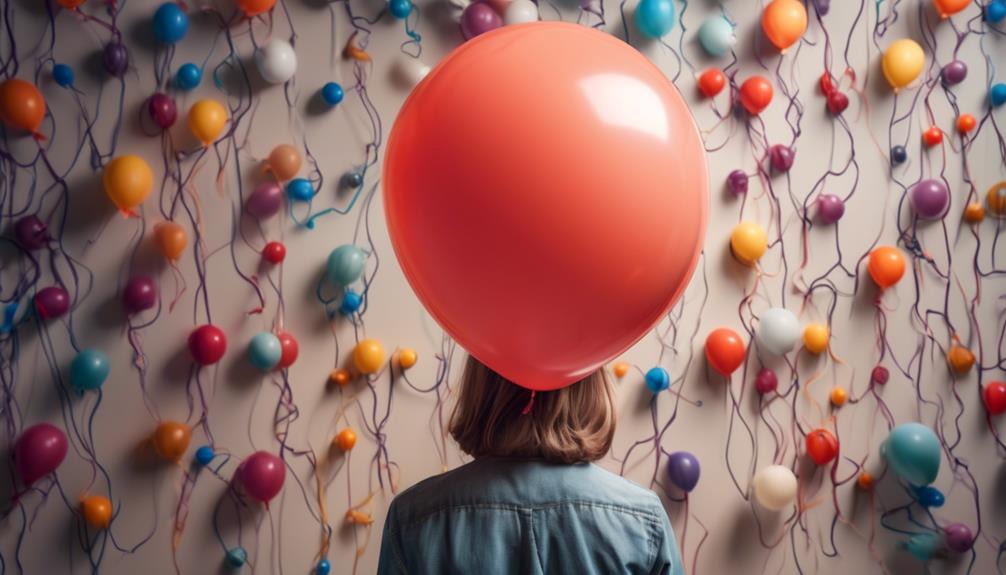
When it comes to understanding the science behind attraction, we can't ignore the role of static electricity and surface interactions. These forces play a crucial part in explaining how objects are drawn to each other or repelled.
Static Electricity Explanation
To understand the phenomenon of the rubbed balloon sticking to a wall, it's essential to delve into the intricate science of static electricity and the underlying principles of attraction at play.
When a balloon is rubbed against hair or wool, it gains an electric charge, either positive or negative. This charge imbalance creates an electrostatic force, causing the balloon to stick to the wall.
The wall, in turn, becomes polarized, with the opposite charge to that of the balloon, leading to attraction due to the electric charges.
Additionally, adhesion factors come into play as the surface of the wall and the balloon interact at a microscopic level, enhancing the sticking effect.
Understanding these electric charges and adhesion factors is crucial to comprehending the captivating nature of static electricity.
Surface Interaction Demonstration
Exploring the surface interaction demonstration provides a deeper understanding of the underlying science governing the captivating phenomenon of attraction through static electricity. In the friction demonstration, we observe how the rubbed balloon's surface adhesion to the wall is a result of the transfer of electrons. As the balloon is rubbed against a material, it gains extra electrons, giving it a negative charge. When brought close to the neutral wall, the negative charges on the balloon repel the electrons in the wall, creating a positively charged area. This attraction is a result of the imbalance of charges – an essential concept in understanding surface adhesion. The demonstration of friction and surface adhesion provides a tangible way to comprehend the scientific principles underlying the intriguing behavior of static electricity.
| Material Rubbed on Balloon | Charge Acquired |
|---|---|
| Wool | Negative |
| Silk | Negative |
| Fur | Negative |
Understanding Electric Charges
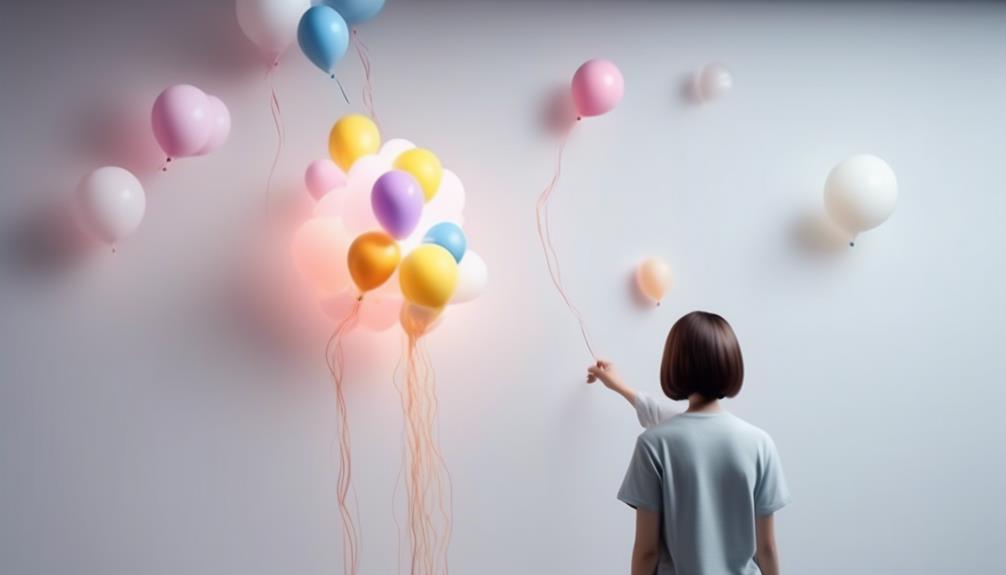
How do objects become electrically charged and what causes them to attract or repel each other? Understanding electric charges involves exploring the intricacies of charge distribution and electron transfer. Here's what you need to know:
- Charge Distribution: When objects are rubbed together, the electrons from one object can transfer to the other. This leads to an unequal distribution of charges, resulting in one object becoming negatively charged and the other positively charged.
- Electron Transfer: The transfer of electrons is what causes objects to become electrically charged. For example, when a balloon is rubbed against hair, electrons are transferred from the hair to the balloon, causing the balloon to become negatively charged.
- Attraction and Repulsion: Objects with opposite charges (positive and negative) will attract each other, while objects with like charges (positive-positive or negative-negative) will repel each other. This is due to the interaction of the electric fields surrounding the charged objects.
- Conductors and Insulators: Understanding electric charges also involves knowing how different materials conduct or insulate charge. Conductors allow charge to flow freely, while insulators restrict the flow of charge, impacting how objects become charged and interact with each other.
Understanding these fundamental principles of electric charges provides insight into the captivating phenomenon of objects attracting and repelling each other based on their electrical properties.
Factors Affecting Adhesion
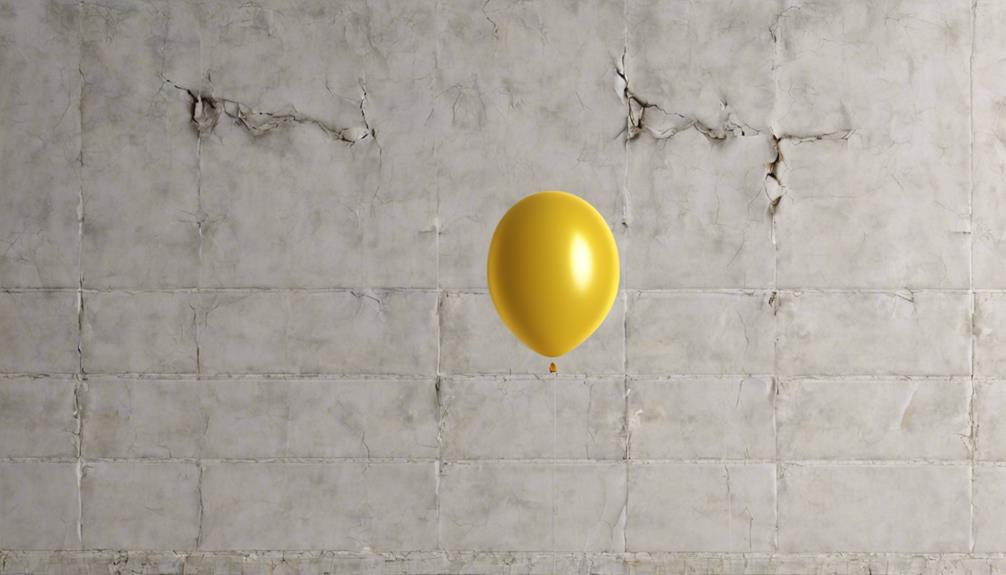
Factors affecting adhesion can vary significantly depending on the surface properties and environmental conditions involved.
Surface properties such as roughness, chemistry, and texture play a crucial role in determining the adhesion strength between two surfaces. For instance, a rough surface provides more area for intimate contact, leading to stronger adhesion, while a smooth surface may hinder adhesion due to reduced contact points.
Additionally, the chemical composition of the surfaces influences adhesion, as certain materials exhibit stronger intermolecular forces, promoting better adhesion.
Environmental conditions, such as temperature and humidity, also impact adhesion strength. High temperatures can soften materials, increasing their conformability and improving adhesion, while humidity can affect the surface energy of materials, consequently influencing adhesion.
Understanding these factors is essential for predicting and controlling adhesion in various applications. By carefully considering surface properties and environmental conditions, one can optimize adhesion strength for specific purposes, whether it's in industrial processes, medical adhesives, or everyday phenomena like a rubbed balloon sticking to a wall.
Wall Interaction Explanation
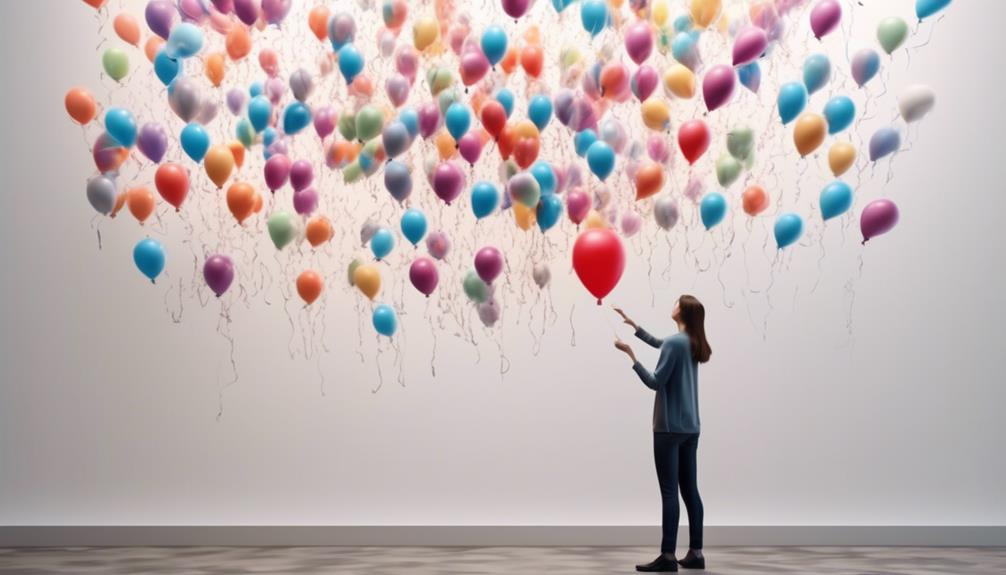
The adhesion strength between a rubbed balloon and a wall can be attributed to the intermolecular forces and surface properties at play, leading to a fascinating wall interaction explanation. When a rubbed balloon is pressed against a wall, several factors come into play to create this intriguing phenomenon.
Here's an explanation of the wall interaction between a rubbed balloon and a wall:
- Frictional Force: The frictional force between the wall and the balloon's surface causes them to stick together. This force is a result of the roughness of the surfaces and the interlocking of microscopic protrusions.
- Molecular Interaction: The molecules on the balloon's surface interact with the molecules on the wall due to van der Waals forces, creating a temporary molecular bond that holds the balloon in place.
- Surface Charge: The rubbing of the balloon against a surface causes a transfer of charge, leading to an imbalance of electrons. This creates an electrostatic attraction between the balloon and the oppositely charged wall, enhancing the adhesion.
- Adhesion: The combination of these factors results in adhesion, where the molecules of the balloon and the wall attract each other, causing the balloon to stick to the wall.
Understanding these interactions sheds light on the captivating nature of this everyday phenomena.
Importance of Surface Material
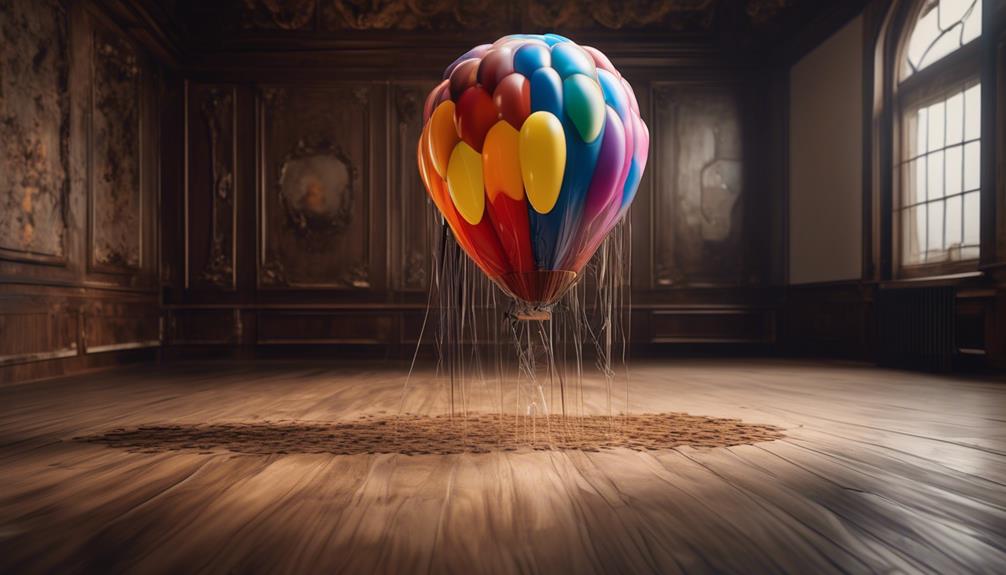
Importance of the surface material significantly influences the adhesion strength between a rubbed balloon and a wall, playing a crucial role in the intriguing phenomenon of their interaction.
Surface adhesion is influenced by various material properties such as roughness, smoothness, and the presence of impurities.
The type of material the wall is made of can significantly impact the adhesion factors at play. For example, a rough-textured wall might provide more surface area for the charges on the balloon to interact with, thereby increasing the adhesive force. On the other hand, a smoother wall might offer less opportunity for the charges to interact, resulting in weaker adhesion.
Additionally, the presence of moisture or surface contaminants can further affect the adhesion strength.
Understanding these material properties and their impact on surface adhesion is crucial for explaining why a rubbed balloon sticks to some walls more than others.
Therefore, the surface material is a pivotal aspect to consider when investigating the intriguing interaction between a rubbed balloon and a wall.
Balloon's Electrical Charge

Exploring the electrical charge of the rubbed balloon leads us to uncover the intricate forces at play in its interaction with different surfaces. When a balloon is rubbed against hair or wool, charge transfer occurs, resulting in the balloon becoming negatively charged. This charge imbalance is crucial to understanding why the balloon sticks to a wall.
Here's a breakdown of the balloon's electrical charge and its role in wall adhesion:
- Charge Transfer: When the balloon is rubbed against certain materials, such as hair or wool, electrons are transferred from the material to the surface of the balloon. This transfer leaves the balloon with a negative charge, while the material becomes positively charged.
- Electrostatic Attraction: The negatively charged balloon is attracted to the positively charged wall through electrostatic forces. This attraction is due to the opposite charges seeking to neutralize each other.
- Polarization: The negatively charged balloon induces a temporary polarization in the wall, causing the positive charges in the wall to move slightly towards the balloon.
- Surface Material Influence: The type of surface material plays a significant role in this process, as it affects the extent of charge transfer and the resulting adhesion strength.
Understanding the intricate nature of the balloon's electrical charge illuminates the phenomenon of wall adhesion, providing a fascinating glimpse into the world of electrostatic forces.
Influence of Air and Humidity
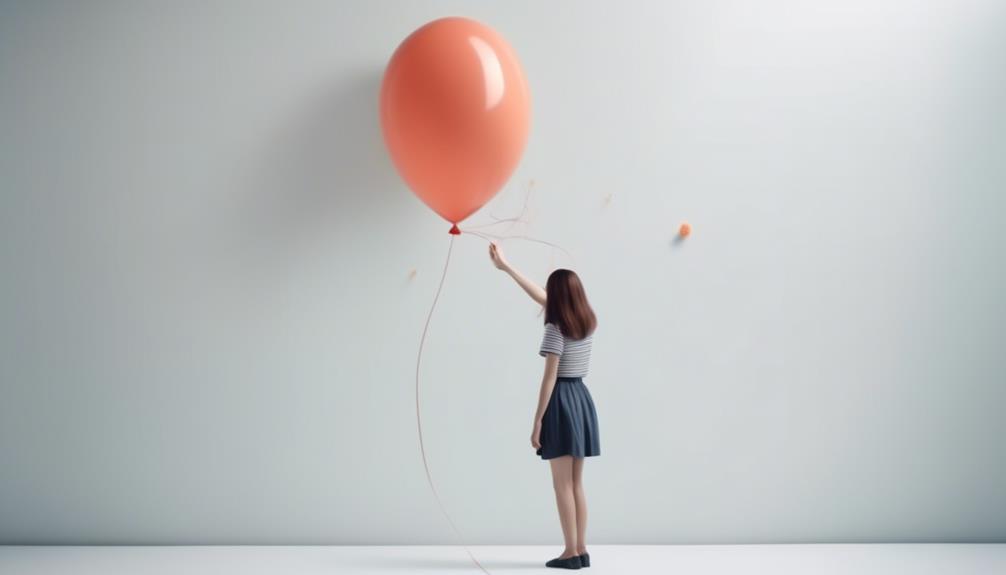
When it comes to the influence of air and humidity on a rubbed balloon sticking to a wall, we need to consider the impact of air pressure and moisture on adhesion.
The air pressure in the environment can affect the balloon's ability to stick to the wall, as changes in pressure can alter the forces at play.
Additionally, the presence of moisture in the air can also influence the balloon's adhesion, as water molecules can interact with the surface of the wall and the balloon, potentially affecting the strength of the bond.
Air Pressure Effect
The air pressure and humidity in the environment play a crucial role in the phenomenon of a rubbed balloon sticking to a wall. When discussing the air pressure effect, it's essential to consider several key factors:
- Air Pressure Dynamics: Changes in air pressure can affect the ability of the balloon to stick to the wall. Higher air pressure can enhance the sticking effect, while lower air pressure may reduce it.
- Humidity Influence: Humidity levels can impact the balloon's ability to stick to the wall. Higher humidity can increase the sticking effect due to the presence of moisture, while lower humidity may diminish it.
- Temperature Variations: Fluctuations in temperature can alter air pressure and humidity, thereby influencing the balloon's adhesion to the wall.
- Surface Conditions: The texture and composition of the wall's surface also play a role in the sticking phenomenon, interacting with air pressure and humidity dynamics.
Understanding these factors helps illuminate the intricate interplay between air pressure, humidity, and adhesion in the context of a rubbed balloon sticking to a wall.
Moisture and Adhesion
In considering the influence of air and humidity on moisture and adhesion, our analysis reveals a nuanced interplay between these environmental factors and the adhesive properties of the rubbed balloon when adhering to a wall. Moisture control is a critical factor in understanding the adhesion mechanisms at play in this scenario. The presence of moisture on the wall can significantly impact the ability of the rubbed balloon to adhere effectively. When the air is humid, the water molecules in the air can accumulate on the surface of the wall, altering its texture and creating a thin layer of moisture. This layer can either enhance or hinder the adhesive properties of the balloon, depending on the specific conditions. Understanding and controlling moisture levels are crucial in predicting the balloon's adhesion behavior.
| Moisture Control | Adhesion Mechanisms | Environmental Impact |
|---|---|---|
| Humid air can lead | Water molecules in | Moisture on the wall |
| to moisture buildup | the air can affect | can alter texture |
| on the wall | adhesion properties | and affect adhesion |
Applications in Everyday Life

Rubbing a balloon and then sticking it to a wall demonstrates the principle of static electricity, a phenomenon with various practical applications in everyday life. Static electricity and its related material properties have led to innovations that impact our daily routines.
Here are some everyday applications of static electricity:
- Photocopiers: Static electricity is used in photocopiers to attract toner particles to the paper, creating a replica of the original document. This process relies on the principles of static electricity to produce accurate copies efficiently.
- Air Purification: Electrostatic precipitators use static electricity to remove dust, pollen, and other particles from the air. As air passes through the device, the particles become charged and are then attracted to oppositely charged plates, effectively purifying the air.
- Painting and Coating: In industries, static electricity is utilized to evenly coat materials such as cars, furniture, and machinery. The charged paint particles are attracted to the grounded object, resulting in a smooth and uniform finish.
- Packaging: Static electricity is employed in packaging processes to control the movement of materials. By using static charges, manufacturers can manipulate materials to adhere to specific surfaces, aiding in the packaging of various products.
Understanding the everyday applications of static electricity allows us to appreciate its significance in simplifying and improving our lives.
Safety Considerations
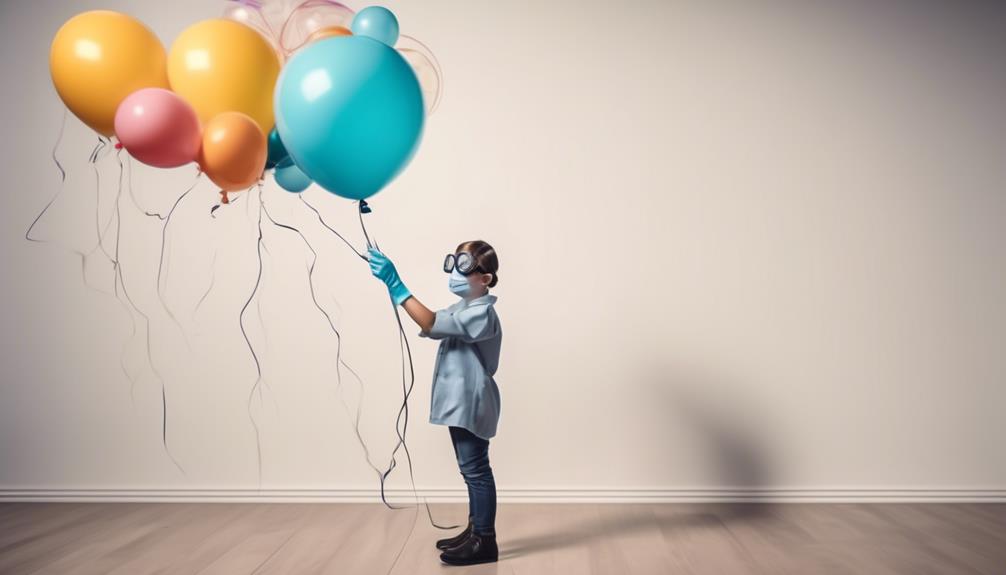
Demonstrating the practical applications of static electricity in everyday life, it's crucial to address the safety considerations associated with its use in various industries and technologies. When handling balloons for static electricity demonstrations, safety precautions must be taken to avoid potential hazards.
First and foremost, it's essential to ensure that the balloons used are free from any defects or damages that could lead to bursting during the rubbing process. Additionally, individuals should be cautious not to overinflate the balloons, as this can also increase the risk of bursting.
Moreover, when considering the wall surface for the balloon experiment, material compatibility is key. It's important to choose a wall surface that's clean and dry, as moisture or dirt can affect the balloon's ability to create static electricity and adhere to the wall. Furthermore, the wall material should be suitable for the experiment to prevent any damage or markings. Avoid rough or abrasive surfaces that could potentially puncture the balloon or leave residue on the wall.
Experiment Variations
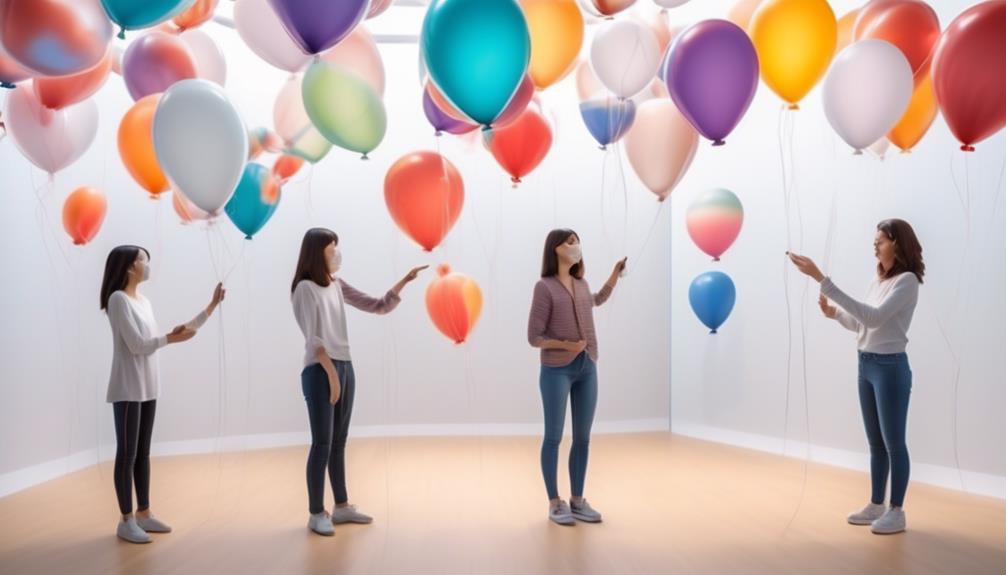
Exploring various modifications to the experiment can yield valuable insights into the behavior of static electricity and its interaction with different materials. By tweaking certain aspects of the setup, we can gain a deeper understanding of the underlying principles at play. Here are some potential experiment variations to consider:
- Control variables: Keeping certain factors consistent while changing others can help isolate the specific effects of different variables. For instance, maintaining a constant room temperature or humidity level can help ensure that any observed changes in the balloon's behavior are due to the manipulated variables and not external factors.
- Material changes: Experimenting with different materials for the balloon and the wall can provide valuable information about how static electricity interacts with various surfaces. Try using different types of balloons (latex, Mylar, etc.) or different wall materials (wood, plastic, etc.) to see how the sticking behavior is affected.
- Distance alterations: Adjusting the distance between the balloon and the wall can offer insights into the range of static electricity effects. By systematically varying the distance and observing the outcomes, we can gather data on the strength and reach of static charges.
- Data analysis: After conducting the variations, careful analysis of the collected data is crucial. Look for patterns, correlations, and anomalies to draw meaningful conclusions about the behavior of static electricity in each scenario. By examining the results in detail, we can uncover valuable insights into the complex dynamics at play.
Educational Significance
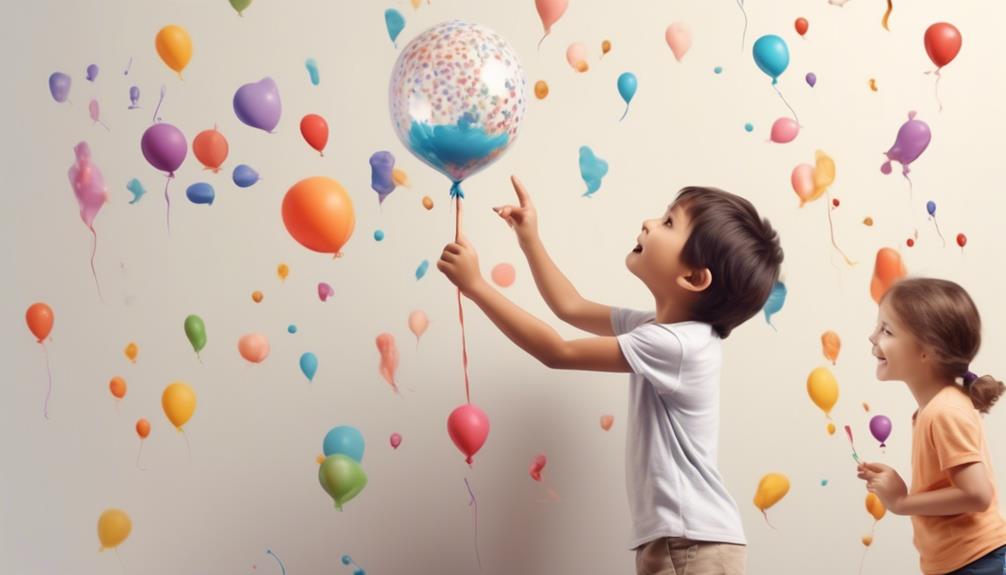
As we consider the educational significance of the rubbed balloon experiment, it's important to understand the underlying principles of static electricity and its practical applications.
This experiment offers a tangible demonstration of electrical charges and their interactions, making it a valuable tool for teaching the basics of electrical phenomena.
Additionally, the variations of this experiment provide opportunities to explore different materials and environmental factors that affect static electricity, fostering a deeper understanding of the scientific method and experimental design.
Static Electricity Explanation
Rubbing a balloon against a surface creates static electricity, which can be explained as a buildup of electric charge on the surface of an object. The phenomenon occurs due to charge transfer, where electrons are transferred from one surface to another, causing an excess of negative or positive charge. This imbalance of charges leads to the creation of electrostatic forces, which are responsible for the intriguing behavior of the rubbed balloon.
Here's what happens:
- Electron Transfer: Rubbing the balloon against a surface causes electrons to transfer from one to the other.
- Charge Imbalance: This transfer results in an imbalance of positive and negative charges on the balloon and the surface.
- Electrostatic Attraction: The charged balloon and the oppositely charged wall are attracted to each other.
- Sticking Effect: The electrostatic forces enable the balloon to stick to the wall, showcasing the impact of static electricity.
Science Experiment Ideas
Conducting science experiments provides an invaluable opportunity for students to explore and understand fundamental scientific principles through hands-on activities and observation. When it comes to understanding the phenomenon of a rubbed balloon sticking to a wall, exploring electric charge and adhesion factors through various experiments can be enlightening. Here are some science experiment ideas to delve into these concepts:
| Experiment Title | Objective | Materials Needed |
|---|---|---|
| Charge Transfer | To demonstrate the transfer of electric charge using a balloon and different materials | Balloon, wool, paper pieces |
| Adhesion Investigation | To explore the factors affecting adhesion | Rubbed balloon, various surfaces (wood, glass, fabric) |
| Static Electricity | To observe the effects of static electricity | Balloon, hair, small pieces of paper |
These experiments allow students to directly observe and analyze the principles of electric charge and adhesion factors, fostering a deeper understanding of these concepts.
Further Exploration Opportunities
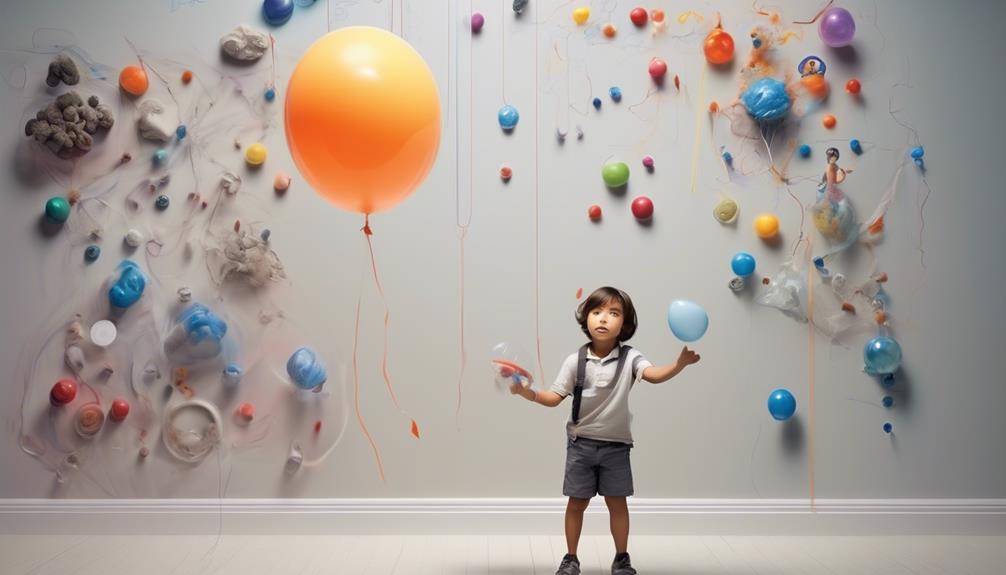
Exploring the phenomenon of a rubbed balloon sticking to a wall presents an opportunity to delve deeper into the underlying principles of static electricity and adhesion. There are various avenues for further exploration that can enhance our understanding of this intriguing occurrence.
- Material properties: Investigate how different materials affect the amount of charge transferred when rubbed against the balloon. This exploration can provide insights into the role of material composition in generating static electricity.
- Adhesion factors: Explore the influence of surface texture and temperature on the balloon's adhesion to the wall. Understanding how these factors impact adhesion can shed light on the underlying mechanisms at play.
- Electrostatic interactions: Delve into the electrostatic forces involved in the phenomenon. This exploration can help unravel the complexities of charge distribution and how it influences the balloon's behavior.
- Real-world applications: Explore practical applications of static electricity and adhesion in industries such as manufacturing, robotics, and aerospace. Understanding these applications can offer valuable insights into how this fundamental scientific principle impacts various fields.
Frequently Asked Questions
Can Static Electricity Be Harmful to Humans or Electronics?
Static electricity can have a significant impact on health and electronic devices. While it may not pose a direct threat to humans, static electricity can cause discomfort and annoyance. However, in certain situations, it can lead to static shocks which may be harmful.
In terms of electronic devices, static electricity can potentially damage sensitive components and disrupt their functionality. Therefore, it's important to take precautions to minimize the effects of static electricity on both health and electronic devices.
How Does the Type of Material Impact the Balloon's Ability to Stick to the Wall?
How does the type of material impact the balloon's ability to stick to the wall?
Material impact on wall adhesion is significant. The wall's surface and the balloon's charge interact, causing an attractive force. For instance, rougher surfaces may increase the contact area, enhancing adhesion. Conversely, smoother surfaces may reduce contact, affecting adhesion.
The material type influences this interaction, affecting the strength of the bond. Understanding this interplay is crucial for predicting and controlling balloon adhesion.
Are There Any Real-Life Applications Where Understanding Static Electricity Is Important?
Real life applications of understanding static electricity are abundant. In industries like manufacturing, electronics, and healthcare, static electricity can cause hazards like fires or damage sensitive equipment.
Practical uses include static control measures in clean room environments and safety precautions for handling flammable materials. Understanding static electricity helps us implement safety measures to prevent accidents and protect equipment from damage.
What Are Some Variations of the Balloon Experiment That Can Be Conducted to Further Explore Static Electricity?
When exploring variations of the balloon experiment to delve deeper into static electricity, we can conduct friction experiments to observe charge transfer and conductivity investigations. These variations can include different materials for rubbing the balloon, such as wool or fur, to explore their impact on charge transfer.
We can also use an electroscope to demonstrate the build-up of static charge and its effects, providing a deeper understanding of static electricity in a hands-on manner.
Are There Any Safety Precautions That Should Be Taken When Conducting Experiments Involving Static Electricity?
When conducting static electricity experiments, safety precautions are crucial. Our experimental setup always includes safety measures such as wearing non-conductive gloves and eye protection.
Potential dangers, like accidental shocks or fires, are minimized through proper grounding of equipment and using insulated tools.
It's vital to maintain a safe distance from power sources and flammable materials.
Following these precautions ensures a secure environment for exploring the fascinating world of static electricity.
Conclusion
In conclusion, the simple balloon experiment has allowed us to understand the captivating nature of static electricity.
Just like how the charged balloon sticks to the wall, we too can be drawn to the positive energy and connections around us.
By embracing the power of attraction, we can create meaningful and impactful experiences in our everyday lives.
So, let's harness the energy of static electricity and stick to the people and opportunities that bring brightness to our world.
- About the Author
- Latest Posts
Introducing Ron, the home decor aficionado at ByRetreat, whose passion for creating beautiful and inviting spaces is at the heart of his work. With his deep knowledge of home decor and his innate sense of style, Ron brings a wealth of expertise and a keen eye for detail to the ByRetreat team.
Ron’s love for home decor goes beyond aesthetics; he understands that our surroundings play a significant role in our overall well-being and productivity. With this in mind, Ron is dedicated to transforming remote workspaces into havens of comfort, functionality, and beauty.
Valentine's Day Decoration
How to Decorate Class for Valentine's Day?
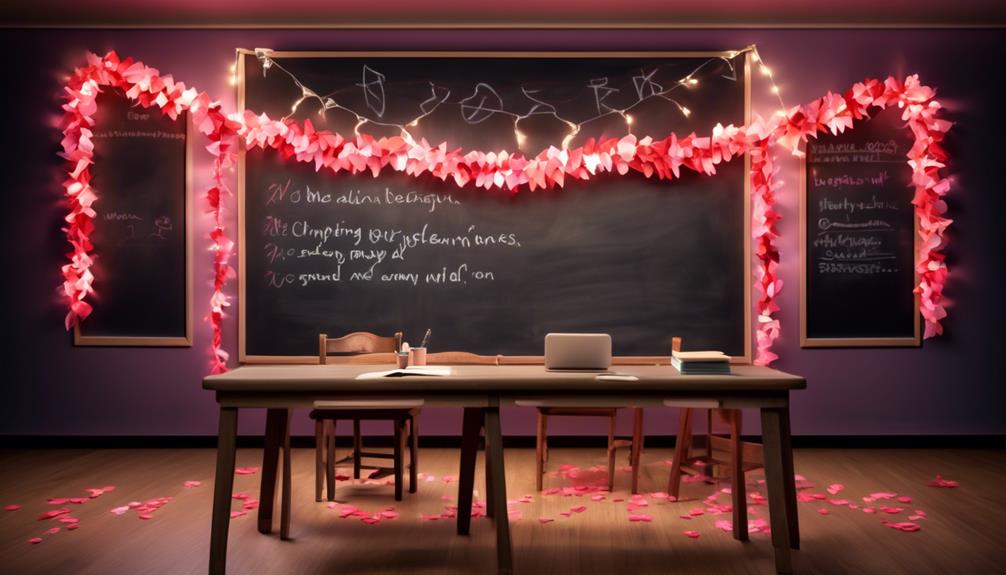
When it comes to decorating a classroom for Valentine’s Day, it’s like painting a canvas with love and creativity. The vibrant hues and heart-shaped accents bring a sense of warmth and joy to the learning environment, making it an exciting space for both teachers and students.
From simple yet impactful paper heart cutouts to elaborate DIY wreaths, there are countless ways to infuse the spirit of Valentine's Day into the classroom. But where to begin? How to strike the perfect balance between festive and educational?
Let's explore some thoughtful and practical ideas for creating a Valentine's Day ambiance that will delight everyone who walks through the door.
Key Takeaways
- Use heart-themed decorations such as colorful paper heart cutouts, romantic garland decorations, DIY Valentine's Day wreaths, heartfelt classroom door decor, and festive love-themed bulletin boards.
- Incorporate creative border designs and interactive learning activities to make the classroom more engaging.
- Include inspirational quotes to create a positive and uplifting atmosphere.
- Implement engaging crafts and festive displays to add a fun and festive touch to the classroom decor.
Colorful Paper Heart Cutouts
Let's gather our colorful paper and scissors, and let's get ready to create some delightful paper heart cutouts for Valentine's Day! What better way to add a touch of love and creativity to our classroom artistry than with these charming heart cutouts? This activity not only sparks joy but also encourages creative craft ideas.
To begin, fold the paper in half and draw half a heart along the folded edge. Then, cut along the line, and voilà, you have a perfect heart shape! Now, let's unleash our imagination and decorate these hearts with glitter, stickers, and markers. Each heart can be a unique masterpiece, reflecting the individuality of every student in our classroom.
These paper heart cutouts can be used to adorn our bulletin board, hang from the ceiling, or even as personalized Valentine's Day cards. They're a wonderful way to spread love and warmth throughout our classroom. Engaging in this simple yet meaningful craft activity fosters a sense of togetherness and joy, making our classroom a place where creativity flourishes.
Let's celebrate the spirit of Valentine's Day by infusing our classroom with these delightful paper heart cutouts.
Romantic Garland Decorations

Our classroom is already brimming with the love and creativity of our charming paper heart cutouts, and now it's time to add an extra touch of romance with our delightful Romantic Garland Decorations.
Picture this: delicate garlands of twinkling fairy lights intertwined with red and pink ribbons, draped across the classroom, casting a warm, intimate glow.
As we prepare for Valentine's Day, these garlands will infuse our space with an enchanting ambiance, perfect for the romantic candlelit dinner or an intimate movie night that we've planned.
We'll hang these garlands with tender care, letting them cascade gently from the ceiling to create an ethereal effect. To enhance the romantic atmosphere, we might even weave in some fragrant eucalyptus or sprigs of baby's breath.
The soft, ambient light from the garlands will set the mood beautifully, whether we're enjoying a cozy dinner together or settling in for a heartwarming movie.
It's amazing how such simple decorations can transform our classroom into a sanctuary of love and warmth, making this Valentine's Day an occasion to remember.
DIY Valentine's Day Wreaths
With Valentine's Day approaching, we are eager to craft charming DIY Valentine's Day wreaths to adorn our classroom with love and creativity. There's something special about creating handmade decorations that infuse the room with warmth and affection. To inspire your creativity, here are some delightful Valentine's Day wreath ideas and DIY wreath tutorials to spread the love throughout our classroom.
| DIY Wreath Ideas | Tutorial Link |
|---|---|
| Heart-Shaped Wreath | [Tutorial](https://www.example.com) |
| Floral Love Wreath | [Tutorial](https://www.example.com) |
| Cupid's Arrow Wreath | [Tutorial](https://www.example.com) |
| Romantic Roses Wreath | [Tutorial](https://www.example.com) |
| Sweetheart Ribbon Wreath | [Tutorial](https://www.example.com) |
Creating these beautiful wreaths together will not only add a touch of love to our classroom but also provide us with a delightful bonding experience. Let's gather our materials and get crafty as we prepare to make our classroom a cozy haven for Valentine's Day!
Heartfelt Classroom Door Decor
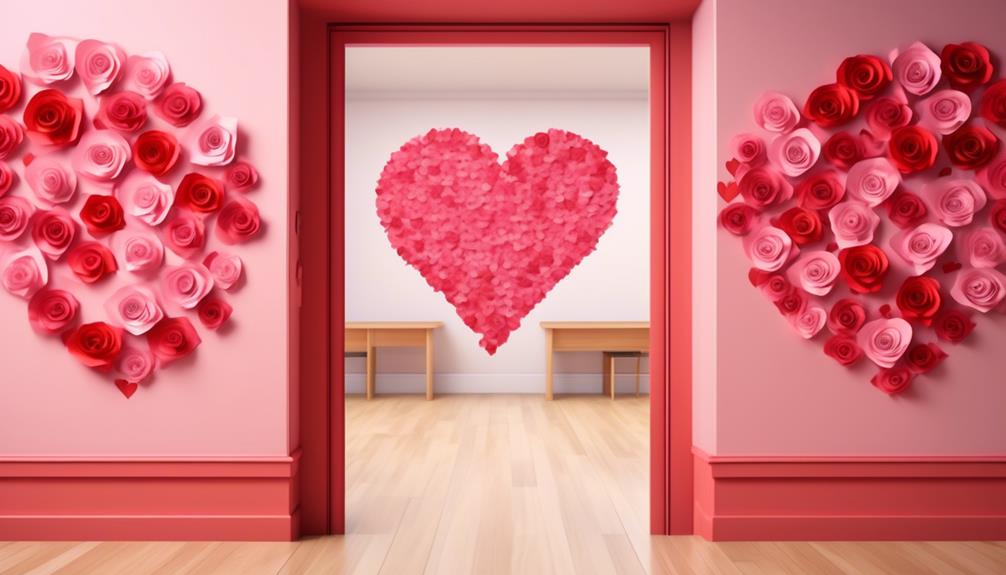
Adorning our classroom door with heartfelt decorations will fill our space with love and creativity, setting the perfect tone for Valentine's Day. Let's create a welcoming and enchanting entryway that celebrates the spirit of love.
To start, we can design a classroom mural on the door using vibrant colors and heartwarming messages. The mural could feature adorable cupids, charming lovebirds, and delightful heart-shaped flowers, evoking a sense of joy and romance.
In addition to the mural, we can sprinkle heart-shaped confetti around the door to add a touch of whimsy and playfulness. The confetti will bring a festive atmosphere to our classroom and make everyone feel special and cherished as they enter.
Furthermore, we can personalize the door with heartfelt messages and love notes from the students, creating a heartwarming display of affection and appreciation. This won't only brighten up the space but also foster a sense of connection and unity among the class.
Let's infuse our classroom door with love and warmth, making it a beautiful and heartwarming focal point for Valentine's Day.
Festive Love-themed Bulletin Boards
Let's bring our classroom to life with love-themed bulletin boards that will enchant and inspire everyone for Valentine's Day. Imagine walking into our classroom and being greeted by vibrant displays of love and creativity. We can make our bulletin boards the heart of our classroom, reflecting the joy and warmth of the holiday. To achieve this, we can incorporate creative border designs and interactive learning activities that engage and delight our students.
| Creative Border Designs | Interactive Learning Activities | Inspirational Quotes |
|---|---|---|
| Heart-shaped borders | Love-themed word searches | "In a world where you can be anything, be kind." |
| Sparkly red and pink patterns | Love letter writing station | "You are loved more than you will ever know." |
| Cupid and arrow motifs | Valentine's Day trivia | "Love is all you need." |
Frequently Asked Questions
How Can I Incorporate Valentine's Day Decorations Into My Classroom Without Spending a Lot of Money?
Inexpensive decorations are the key, and involving students makes it even more special. We can create a cozy atmosphere with handmade heart garlands, paper roses, and love-themed crafts.
Let's encourage students to bring in their own creations to decorate the classroom. It's a sweet way to involve everyone and make the space feel warm and full of love, without breaking the bank.
Are There Any Interactive Activities or Games I Can Use to Engage My Students With the Valentine's Day Decorations?
Interactive activities and engaging games are the perfect way to involve students with the Valentine's Day decorations.
We can organize a scavenger hunt, where students search for love-themed items hidden around the classroom.
Another idea is to have a Valentine's Day crafting station where students create their own decorations.
This involvement not only enhances the classroom decor but also fosters a sense of creativity and excitement among the students.
Are There Any Specific Safety Considerations I Should Keep in Mind When Decorating My Classroom for Valentine's Day?
Safety precautions are crucial when decorating our classroom for Valentine's Day. We must carefully consider the layout and conduct a risk assessment to ensure everyone's safety.
Like a gentle embrace, fire hazards should be minimized, and decorations shouldn't obstruct pathways.
Let's infuse our classroom with love while keeping everyone safe. It's important to create a warm, enchanting atmosphere without compromising on safety.
How Can I Involve My Students in Creating and Putting up the Valentine's Day Decorations?
We can involve our students in creating and putting up the Valentine's Day decorations by organizing fun DIY decoration sessions. It's a wonderful way to foster creativity and teamwork.
We could encourage them to make heart-shaped garlands, paper flowers, and personalized cards. By involving them in the process, we're not only creating a lovely atmosphere but also nurturing their artistic skills and making them feel like an essential part of the classroom's festive transformation.
Are There Any Specific Cultural or Religious Considerations I Should Be Aware of When Decorating for Valentine's Day in a Classroom Setting?
Cultural sensitivities and classroom diversity are crucial as we plan our Valentine's Day decorations. Recognizing and respecting religious observances in our inclusive decorations is key. We want to ensure that everyone feels valued and included.
Let's infuse creativity and warmth into our decorations, embracing the joy of celebrating love in a way that honors all backgrounds. It's an opportunity to foster unity and understanding among our diverse students.
Conclusion
So there you have it – with just a few simple decorations, you can turn your classroom into a love-filled space for Valentine's Day.
Whether it's colorful paper heart cutouts, romantic garland decorations, DIY wreaths, heartfelt door decor, or festive bulletin boards, there are plenty of ways to spread the love in your classroom.
Get creative, have fun, and enjoy making your classroom a special place for this heartwarming holiday!
- About the Author
- Latest Posts
Introducing Ron, the home decor aficionado at ByRetreat, whose passion for creating beautiful and inviting spaces is at the heart of his work. With his deep knowledge of home decor and his innate sense of style, Ron brings a wealth of expertise and a keen eye for detail to the ByRetreat team.
Ron’s love for home decor goes beyond aesthetics; he understands that our surroundings play a significant role in our overall well-being and productivity. With this in mind, Ron is dedicated to transforming remote workspaces into havens of comfort, functionality, and beauty.
Valentine's Day Decoration
How to Decorate Boxes for Valentine's Day?

Are you curious about how to transform a basic box into a meaningful Valentine’s Day gift? Don’t worry, we have some practical and imaginative ideas to help make your gift boxes special and express how much your loved ones mean to you.
From choosing the right box to adding those final finishing touches, we'll cover everything you need to make your Valentine's Day gifts extra special.
So, if you're ready to elevate your gift-giving game and make this Valentine's Day truly memorable, let's get started.
Key Takeaways
- Choose a box material that exudes elegance or adds a touch of nostalgia.
- Pay attention to the size options and ensure they are just right.
- Add personal touches such as photographs, handwritten notes, or small trinkets.
- Use DIY decorative techniques like decoupage and ribbon embellishments for a beautiful and unique look.
Choosing the Right Box
When selecting the perfect box for Valentine's Day, we aim to find one that not only holds the gifts but also adds to the overall presentation, creating a memorable experience for the recipient.
Box materials play a crucial role in this decision-making process. Opting for a sturdy, high-quality material not only ensures the safety of the gifts but also adds an element of luxury to the overall package. Whether it's a sleek, polished wooden box exuding elegance or a charming, rustic cardboard box adding a touch of nostalgia, the material sets the tone for the entire gifting experience.
Size options also come into play when choosing the right box. The size should be just right, not too big to overwhelm the recipient or too small to limit the gifting possibilities. A medium-sized box offers versatility, accommodating various gifts while still maintaining an element of surprise. It allows for layering different items creatively, adding to the excitement of unwrapping and discovering each carefully curated treasure inside.
Ultimately, the box becomes an integral part of the Valentine's Day gift, enhancing the anticipation and delight of the recipient.
Wrapping With Love

With every fold and tuck, our gift wrapping becomes a canvas for expressing our affection and attention to detail, infusing each package with a touch of heartfelt sentiment. As we prepare to wrap our Valentine's Day gifts, let's take a moment to consider the impact of DIY ribbon and delicate paper flowers in our presentation. These elements add a personal touch and elevate the wrapping experience to a whole new level of intimacy.
| DIY Ribbon | Paper Flowers | Handwritten Notes |
|---|---|---|
| Use strands of fabric or twine to create unique, personalized ribbon for a bespoke touch. | Craft or purchase paper flowers to adorn your gifts, adding a whimsical and romantic flair. | Handwrite love notes or thoughtful messages to tuck into the folds of the wrapping, making the gift even more meaningful. |
Adding Personal Touches
Let's infuse our Valentine's Day gifts with a personal touch that reflects the uniqueness of our relationships and the depth of our affection. Adding personalized embellishments and sentimental decorations can elevate the presentation of our gifts, making them truly unforgettable.
One way to add a personal touch is by incorporating photographs. Select some special snapshots that capture cherished moments with your loved one, and use them to adorn the box. You could create a photo collage or simply attach a single photo along with a heartfelt note.
Another way to add a personal touch is by including handwritten notes or love letters. These intimate messages can be tucked inside the box, serving as a beautiful surprise for your significant other.
Additionally, consider incorporating small trinkets or items that hold special meaning for the both of you. These could be anything from a favorite quote written on a decorative card to a small token that symbolizes a shared memory.
DIY Decorative Techniques
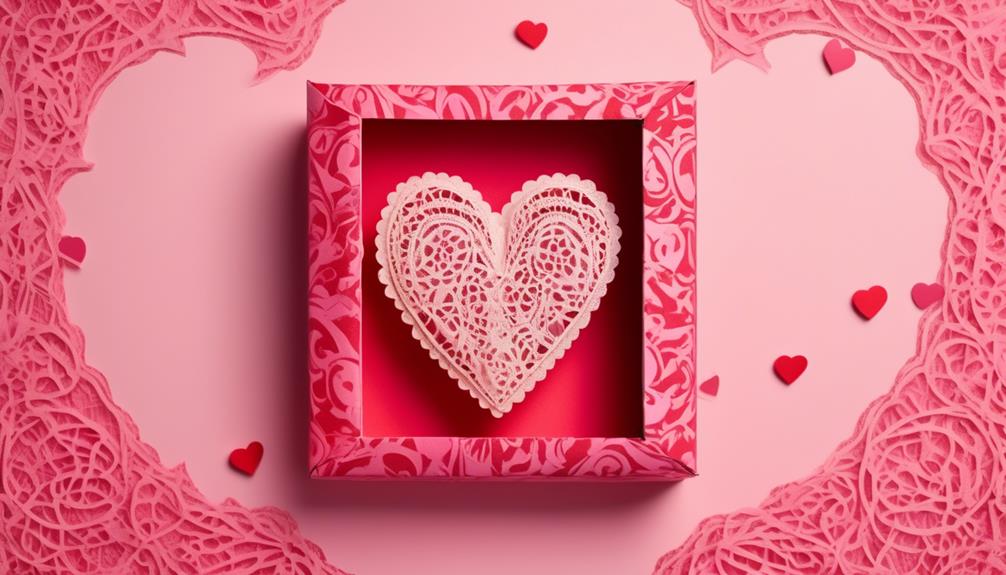
To create stunning and personalized Valentine's Day gift boxes, we can employ various DIY decorative techniques that will add a touch of creativity and charm to our presents. One of the most delightful ways to decorate gift boxes is by using decoupage designs. Decoupage involves layering cut-out paper designs onto the box and sealing them with a varnish or glue, creating a beautiful and textured effect. Additionally, incorporating ribbon embellishments can instantly elevate the look of the box. Whether it's a classic satin ribbon, a rustic twine, or a playful and colorful grosgrain ribbon, the options are endless and can perfectly complement the theme of your Valentine's Day gift.
| Techniques | Materials Needed | Tips |
|---|---|---|
| Decoupage Designs | Patterned paper, Mod Podge | Use a variety of patterns for visual interest. |
| Ribbon Embellishments | Assorted ribbons, Scissors | Mix and match different ribbons for a unique look. |
Finishing Flourishes
As we add the finishing flourishes to our Valentine's Day gift boxes, we can infuse them with a touch of elegance and personality, making each one a delightful expression of our affection.
Adding decorative ribbons is a simple yet effective way to elevate the look of the box. Satin or organza ribbons in red, pink, or even gold can bring a luxurious and romantic feel to the packaging. Tying a bow around the box or creating intricate designs with the ribbons can further enhance the overall appeal.
Incorporating festive embellishments such as heart-shaped charms, faux flowers, or glittery stickers can add a whimsical and playful touch to the boxes. These little details not only make the boxes visually appealing but also create a sense of excitement and anticipation for the recipient.
Frequently Asked Questions
Can I Use the Same Techniques to Decorate Boxes for Other Occasions, Such as Birthdays or Anniversaries?
Adapting techniques for birthdays or anniversaries is a breeze! We love the versatility of using recycled materials for eco-friendly decorations.
When decorating boxes for other occasions, consider the recipient's preferences and the theme of the event.
For long-distance gifting, adding special considerations, like a handwritten note or a small trinket, can make the gift even more meaningful.
Get creative and make each box uniquely perfect for the occasion!
What Are Some Creative Ways to Incorporate Recycled Materials Into My Box Decorations?
When it comes to incorporating recycled materials into our box decorations, we can get super creative. We can use old fabric scraps to create unique textures and patterns, or repurpose buttons, ribbons, and even old magazines for a whimsical touch.
It's not only eco-friendly but also adds a personal and thoughtful element to our decorations. Let's embrace sustainability and infuse our creations with love and care.
Are There Any Tips for Ensuring My Decorations Stay in Place and Don't Fall off the Box?
Ensuring durability and preventing falling decorations is crucial. We've found that using strong adhesive, like hot glue or double-sided tape, is effective for securing embellishments.
Also, reinforcing delicate decorations with clear nail polish or a sealant spray provides extra protection.
For a charming touch, consider adding ribbons or twine to tie everything together.
These methods not only keep the decorations in place but also add a lovely finishing touch to your Valentine's Day box.
How Can I Make My Box Decorations More Environmentally Friendly?
When it comes to making our box decorations more environmentally friendly, we can explore eco-friendly options and sustainable materials. We can get creative with natural elements like dried flowers, leaves, and twine.
Upcycling old fabric or using recycled paper for wrapping can also add an extra touch of sustainability to our decorations. Embracing these choices not only adds a unique and personal touch but also helps to lessen our environmental impact.
Are There Any Special Considerations for Decorating Boxes for Long-Distance Gifting?
When decorating boxes for long-distance gifting, we focus on adding personalized touches that remind the recipient of us. We consider shipping considerations to ensure the package arrives intact and on time, maintaining the surprise.
Including handwritten notes, photos, or small trinkets can make the gift feel extra special. It's about infusing love and thoughtfulness into every detail, so the recipient feels our presence even from afar.
Conclusion
In conclusion, decorating boxes for Valentine's Day is a fun and creative way to show your loved ones how much you care.
With the right box, some wrapping paper, and a few personal touches, you can create a beautiful and heartfelt gift.
So why not try your hand at DIY decorative techniques and add some finishing flourishes to make your Valentine's Day gifts extra special this year?
Happy decorating!
- About the Author
- Latest Posts
Introducing Ron, the home decor aficionado at ByRetreat, whose passion for creating beautiful and inviting spaces is at the heart of his work. With his deep knowledge of home decor and his innate sense of style, Ron brings a wealth of expertise and a keen eye for detail to the ByRetreat team.
Ron’s love for home decor goes beyond aesthetics; he understands that our surroundings play a significant role in our overall well-being and productivity. With this in mind, Ron is dedicated to transforming remote workspaces into havens of comfort, functionality, and beauty.
Valentine's Day Decoration
How to Decorate a Box for Valentine's Day?
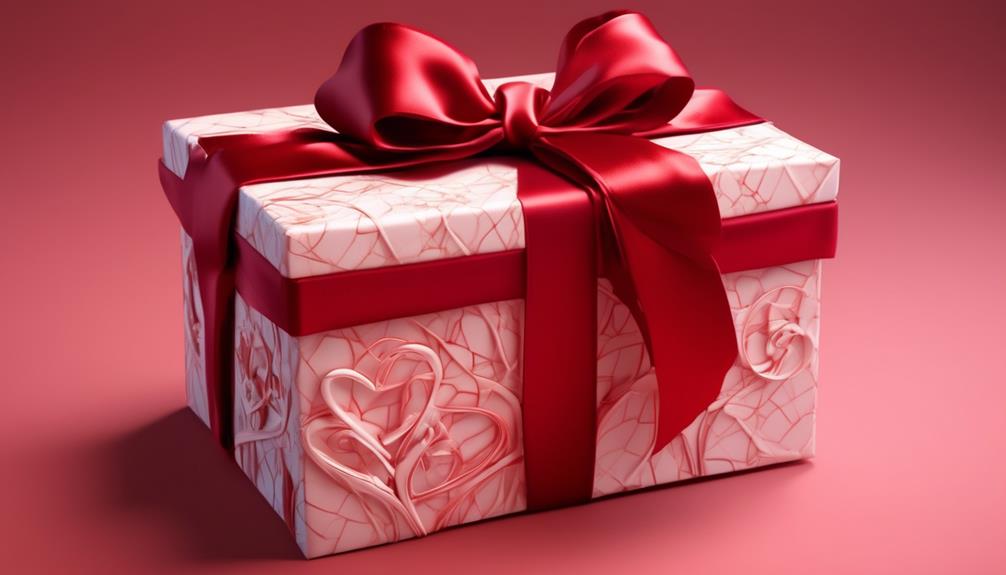
Did you realize that around 145 million Valentine’s Day cards are exchanged every year? That’s a significant amount of love being spread through meaningful actions.
But what about the perfect way to present those heartfelt sentiments? Decorating a box for Valentine's Day adds an extra touch of personalization and charm to the gift-giving experience. From elegant ribbons to playful embellishments, there are countless creative ways to make your gift box stand out.
Whether you're a seasoned crafter or a novice DIY enthusiast, discovering the art of box decoration is an enjoyable and rewarding process.
So, let's explore some unique and inspiring ideas to elevate your Valentine's Day gifting experience.
Key Takeaways
- Consider the size, shape, and material of the box
- Select ribbon colors that complement the box's color scheme
- Colorful ribbons add a playful and vibrant touch
- Heart-shaped stickers add a whimsical touch
Choosing the Right Box
When selecting a box for Valentine's Day decorations, consider the size, shape, and material to ensure it complements the theme and accommodates your chosen embellishments. The box dimensions play a crucial role in determining how much you can embellish and what kind of items you can place inside. A larger box provides more space for creativity, while a smaller one may require a more minimalistic approach. Materials also influence the overall look and feel of the box. Whether it's a rustic wooden box, a delicate fabric-covered one, or a sleek metal container, the material sets the tone for your decorations.
Customized designs and themes add a personal touch to your Valentine's Day box. Consider the theme you want to convey – whether it's classic romance, modern chic, or whimsical charm. Your chosen box should be a canvas that complements and enhances the theme. Whether you opt for elegant lace and floral motifs, bold and vibrant patterns, or sleek and minimalist designs, the box becomes an integral part of the Valentine's Day experience.
Elegant Ribbons and Bows

Let's talk about the art of selecting the perfect ribbon color to complement your box and tying the most elegant bows that will make your Valentine's Day gift truly stand out. We'll explore how different ribbon colors can evoke various emotions and set the tone for your gift, as well as share some creative bow tying techniques that will add a touch of sophistication to your presentation.
With our expert tips, you'll be able to create a beautifully wrapped gift that will express your love in the most elegant way.
Ribbon Color Selection
To create a stunning visual impact, carefully select ribbon colors that complement the overall color scheme of your Valentine's Day box, adding an elegant and cohesive touch to your design. When choosing ribbon colors, consider the following:
- Color Psychology: Delve into the meaning behind different colors to evoke the right emotions. Red signifies love and passion, pink represents sweetness and affection, while purple exudes luxury and romance.
- Pattern Mixing: Experiment with combining different ribbon patterns such as polka dots, stripes, or florals to add depth and visual interest to your box.
- DIY Ribbon Dyeing: Customize your ribbons by dyeing them in shades that perfectly match your box or the recipient's favorite colors.
- Ribbon Texture Options: Explore a variety of textures like satin, organza, or velvet to add tactile appeal and elevate the overall look of your box.
Bow Tying Techniques
Exploring elegant ribbon tying techniques can elevate the visual appeal of your Valentine's Day box, adding a touch of sophistication and charm to your heartfelt gift. When it comes to creating beautiful bows, the right ribbon styles and techniques can make all the difference. Here are some creative bow ideas and tutorials to help you perfect your bow tying skills:
| Ribbon Styles | Techniques |
|---|---|
| Satin ribbon | Classic bow |
| Grosgrain ribbon | Layered bow |
| Velvet ribbon | Floral bow |
| Organza ribbon | Pom-pom bow |
Whether you prefer a classic, layered, floral, or pom-pom bow, mastering these techniques will allow you to create stunning bows that will adorn your Valentine's Day box with elegance and love.
Playful Embellishments
Let's add some fun and whimsy to our Valentine's Day box with playful embellishments.
Colorful ribbons and heart-shaped stickers can bring a lively and cheerful touch to the overall look.
These little details will surely spark joy and excitement when the recipient opens the box.
Colorful Ribbons
Colorful ribbons add a playful and vibrant touch to any Valentine's Day box, creating a cheerful and eye-catching embellishment for your special gift. Here are some creative ways to incorporate colorful ribbons into your box decoration:
- Layered Effect: Experiment with different colors and widths of ribbons, layering them to create a visually appealing effect.
- Intricate Bow Designs: Use ribbons to craft intricate bow designs that add a touch of elegance to your box.
- Contrast and Complement: Choose ribbons that contrast or complement the color of your box, creating a harmonious and balanced look.
- Personalized Tags: Attach personalized tags to the ribbons, adding a heartfelt and personalized touch to your Valentine's Day gift.
Embrace the joy of creativity and personal expression by incorporating colorful ribbons into your box decoration, making your gift truly stand out.
Heart-Shaped Stickers
Heart-shaped stickers are a delightful and whimsical way to add a playful touch to your Valentine's Day box, infusing it with a sense of joy and charm. These little stickers can transform a plain box into a creative craft that radiates a romantic theme.
Imagine adorning your box with an assortment of heart-shaped stickers in various sizes and colors, creating a beautiful collage that reflects the depth of your affection. You can scatter them around like confetti or arrange them meticulously in a heart-shaped pattern, each sticker a testament to your love and creativity.
These stickers aren't just decorative; they carry the warmth of your emotions, elevating your gift to a whole new level of endearment. So, go ahead, let your heart guide your hands as you embellish your Valentine's Day box with these enchanting stickers.
Heartfelt Messages

We express our deepest feelings through handwritten notes, capturing the essence of our love and appreciation. The art of crafting heartfelt messages is a beautiful way to convey our emotions and create cherished moments.
Here are four ways to infuse your Valentine's Day box with the magic of heartfelt messages:
- Handwritten Notes: Take the time to write a personal message from the heart, reminiscing about special moments and expressing gratitude for your loved one's presence in your life.
- Hidden Surprises: Tuck little notes in unexpected places within the box, waiting to be discovered as your loved one explores their gift. These surprises will add an element of delight and anticipation to the experience.
- Creative Calligraphy: Elevate your messages with creative calligraphy, infusing them with an artistic touch that reflects the depth of your feelings.
- Meaningful Quotes: Incorporate meaningful quotes about love and devotion, whether from literature, poetry, or your own sentiments, to add depth and significance to your messages.
Crafting heartfelt messages for your Valentine's Day box is a poignant way to express your love and create a lasting impression.
Personalized Designs
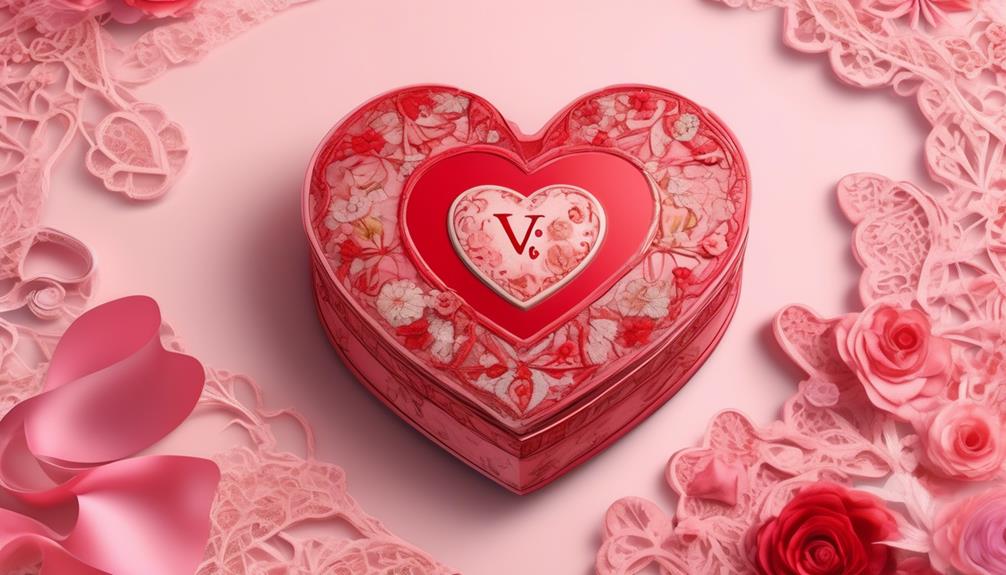
Embracing the essence of individuality, our personalized designs will infuse your Valentine's Day box with a unique and heartfelt touch, capturing the spirit of your relationship in every detail.
When it comes to customized themes, the possibilities are endless. Consider incorporating elements that hold special significance to your relationship, such as the location of your first date, the lyrics of your favorite song, or inside jokes that only the two of you share. These personalized details will make your Valentine's Day box a true reflection of your love story.
Creative patterns can also add a whimsical and charming touch to your box. Whether it's hand-painted florals that hold sentimental value, or playful geometric shapes that represent the dynamic nature of your relationship, the use of creative patterns can elevate the aesthetic appeal of your box and make it a visual representation of your unique bond.
The key is to let your creativity flow and allow your imagination to guide you as you design a box that's as special and one-of-a-kind as the love you share.
Floral and Nature-Inspired Decor

Exploring the beauty of nature, we can infuse our Valentine's Day box with an enchanting array of floral and nature-inspired decor, adding a touch of organic elegance to our personalized creation.
Here are some creative ideas to bring the beauty of the garden into our Valentine's Day box:
- Natural Materials: Incorporate natural elements such as dried flowers, leaves, or small branches to add a rustic touch to the box. These materials not only evoke the charm of the outdoors but also infuse the box with a delightful fragrance.
- DIY Inspiration: Embrace the DIY spirit by creating handmade paper flowers or fabric blooms to adorn the box. This personal touch adds a unique and heartfelt element to the decor, making the gift even more special.
- Garden-Themed Decorations: Consider using garden-themed decorations such as miniature garden tools, tiny watering cans, or faux moss to create a whimsical and enchanting scene on the box. These details will transport the recipient to a tranquil garden oasis.
- Creative Embellishments: Experiment with ribbons, twine, or lace to embellish the box, evoking the natural charm and grace of the outdoors. These simple additions can elevate the overall aesthetic and create a stunning presentation.
Infusing our Valentine's Day box with floral and nature-inspired decor allows us to convey our affection in a beautifully organic way.
Sparkling Glitter and Gems
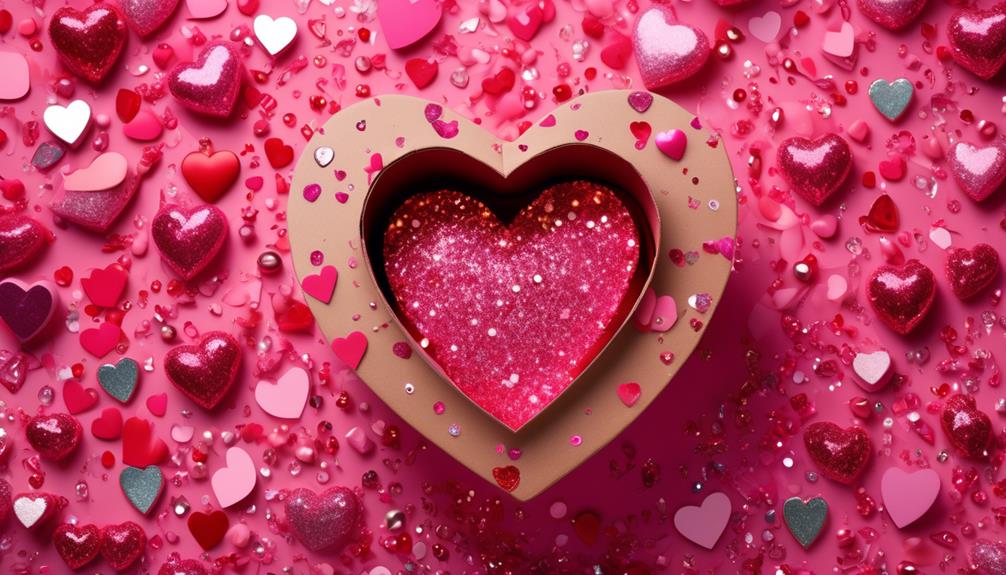
Glistening with the allure of shimmering crystals and radiant jewels, our Valentine's Day box becomes a captivating treasure of love and elegance. As we delve into the world of sparkling glitter and gems, we are transported to a realm of enchantment and opulence. To truly elevate our box to a new level of sophistication, we can adorn it with shimmering rhinestones, casting prismatic reflections that dance in the light. These exquisite gems add a touch of glamour and luxury, embodying the passion and affection we feel for our loved ones.
Now, let's turn our attention to dazzling sequins, which infuse our creation with an iridescent charm. The play of light on these tiny, shimmering discs evokes a sense of jubilation and festivity. Incorporating sequins into our design allows us to express the joy and excitement of love, creating a visual spectacle that mirrors the effervescence of our emotions.
For a clearer understanding, let's look at how these elements compare:
| Shimmering Rhinestones | Dazzling Sequins |
|---|---|
| Reflects light with a prismatic effect | Iridescent and playful |
| Adds a touch of luxury and sophistication | Evokes joy and festivity |
| Symbolizes passion and affection | Expresses the excitement of love |
Incorporating these radiant embellishments into our Valentine's Day box will undoubtedly make it a radiant manifestation of our affection and adoration.
Vintage and Rustic Touches

Let's infuse our Valentine's Day box with a charming vintage vibe by incorporating distressed wood accents, antique lace details, and weathered metal embellishments.
These elements bring a touch of nostalgia and rustic elegance to our creation, evoking a sense of timeless romance and heartfelt sentiment.
Distressed Wood Accents
Incorporating distressed wood accents into the box decor adds a charming vintage and rustic touch that enhances the overall Valentine's Day theme. Here are some creative ways to achieve this:
- Weathered Paint Finish: Using distressed wood techniques, apply a weathered paint finish in soft pastel hues for a romantic, worn look.
- Rustic Wood Burn: Add a personalized touch with a rustic wood burn design, such as initials or a heartfelt message.
- Vintage Hardware: Enhance the box with weathered metal accents like antique drawer pulls or decorative hinges for a touch of vintage appeal.
- Natural Distressing: Embrace the beauty of natural distressing by incorporating salvaged wood pieces or reclaimed barn wood to bring a sense of history and character to the box.
These distressed wood accents will infuse your Valentine's Day box with warmth and nostalgia, making it a truly special gift.
Antique Lace Details
Embracing the vintage and rustic aesthetic from our previous discussion on distressed wood accents, we can now turn our attention to the charming addition of antique lace details to elevate the Valentine's Day box decor.
Vintage lace brings an air of timeless romance, making it the perfect embellishment for a heartfelt gift. Consider using delicate lace trim to adorn the edges of the box lid, creating a soft and elegant frame.
The intricate patterns of vintage lace add a touch of nostalgia and sophistication, evoking the allure of bygone eras. Pairing the lace with rustic elements, such as burlap or twine, creates a beautiful contrast, infusing the design with warmth and character.
Weathered Metal Embellishments
Weathered metal embellishments add a touch of vintage charm and rustic elegance to the Valentine's Day box, infusing it with a captivating sense of history and character. These rustic touches bring warmth and a sense of timelessness to your creation, making it a heartfelt and meaningful gift for your loved one.
Here are four delightful ways to incorporate weathered metal into your Valentine's Day box:
- Vintage Keys: Add a whimsical touch by attaching old, weathered keys to the box, symbolizing the unlocking of your heart.
- Rustic Locks: Incorporate antique locks to convey the idea of protecting and cherishing the love held within the box.
- Aged Metal Hearts: Adorn the box with small, weathered metal hearts to symbolize enduring love and commitment.
- Patina Tags: Attach patina-finished metal tags with personalized messages, adding a unique and personalized touch to your gift.
These elements will infuse your Valentine's Day box with patina perfection and rustic charm, creating a truly memorable and nostalgic keepsake.
Decoupage and Paper Collage

To create a stunning decorative box for Valentine's Day, we can use the artistic techniques of decoupage and paper collage to bring our vision to life. Mixed media art allows us to blend various materials, such as patterned paper, tissue, and fabric, to craft a unique and visually captivating design.
Texture layering adds depth and dimension, creating an enchanting tactile experience. Start by selecting a variety of decorative papers in romantic hues like blush pink, passionate red, and delicate cream. Cut out meaningful images, intricate patterns, and heartfelt phrases from magazines, old love letters, or printed digital designs.
Arrange and layer these elements on the box's surface, allowing them to overlap and intertwine organically. Use a decoupage medium to adhere the pieces, sealing them with a protective topcoat for longevity.
The process isn't only a delightful way to express your affection, but it also results in a one-of-a-kind treasure that embodies the beauty of your relationship. Embrace this creative journey, infusing your heartfelt sentiments into every carefully chosen element.
Unique Painting Techniques

We explore innovative painting techniques that infuse our decorative box with captivating colors and textures, elevating our Valentine's Day creation to new artistic heights.
- Texture Techniques and Color Blending: Experiment with different tools like sponges, brushes, and even unconventional items like plastic wrap or crumpled paper to create unique textures. Blend colors seamlessly to create a mesmerizing and multi-dimensional effect, adding depth and richness to the box's surface.
- Abstract Designs and Mixed Media Applications: Embrace the freedom of abstract expression by using unconventional tools such as toothbrushes, palette knives, or even your fingers to create intriguing patterns and designs. Incorporate mixed media elements like metallic paints, glitter, or even small trinkets to add an unexpected and delightful touch to your box.
- Layering and Stenciling: Experiment with layering different colors and textures to create rich and complex visual interest. Utilize stencils to add intricate patterns or motifs, enhancing the overall aesthetic of the box with a professional and polished look.
- Splatter and Drip Techniques: Embrace spontaneity by using splatter and drip techniques to add dynamic movement and energy to the box's design. This playful and expressive approach can result in a visually captivating and one-of-a-kind piece that truly embodies the spirit of Valentine's Day.
Finishing Touches and Presentation
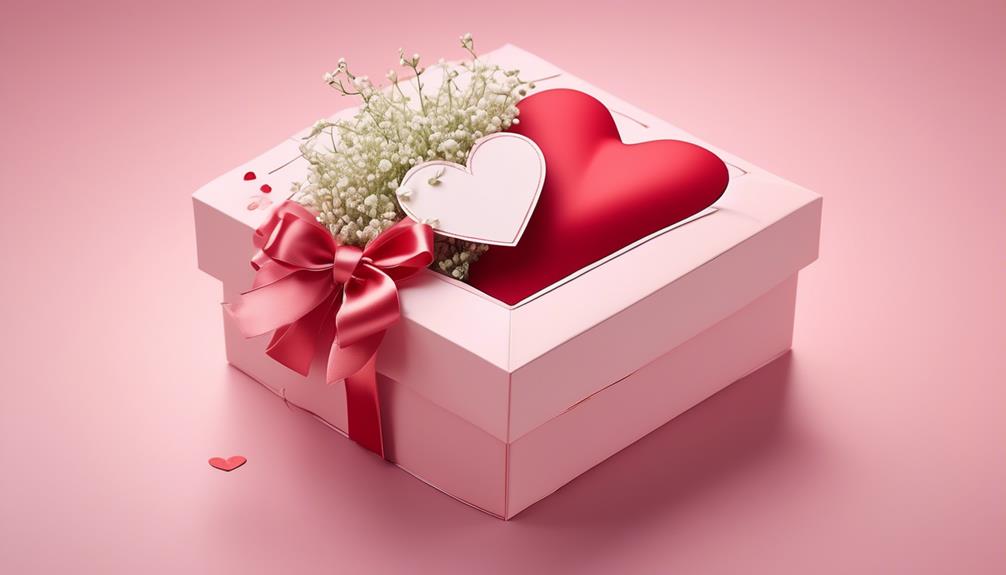
With a meticulous eye for detail and a touch of creativity, we can transform our decorated box into a stunning gift that delights the recipient on Valentine's Day.
After completing our unique painting techniques, it's time to consider the finishing touches and presentation. Creative wrapping ideas can elevate the DIY gift box to a whole new level.
One charming option is to wrap the box in delicate lace, securing it with a satin ribbon for a touch of elegance.
Another idea is to use homemade gift wrapping by decorating plain kraft paper with heart-shaped stamps or hand-drawn designs, adding a personal touch to the presentation.
For a truly enchanting presentation, consider adding a small bouquet of fresh flowers or a sprig of fragrant eucalyptus to the wrapped box. This not only enhances the visual appeal but also adds a delightful aroma to the gift.
Additionally, tying a handwritten note or a meaningful quote to the ribbon can further express the sentiment behind the gift. These thoughtful touches show the recipient the care and effort put into creating a meaningful Valentine's Day gift.
Frequently Asked Questions
Can I Use the Same Techniques to Decorate a Box for Other Occasions, Like Birthdays or Anniversaries?
Absolutely! When it comes to different occasions, the possibilities are endless. Birthdays, anniversaries – we can use the same techniques but switch up the designs to suit the occasion. It's a chance to get creative and craft unique designs that reflect the celebration.
Think colors, themes, and personal touches that capture the spirit of the event. It's all about infusing that special touch into each box, making it a gift in itself.
Are There Any Specific Materials I Should Avoid Using When Decorating a Box for Valentine's Day?
When decorating a box for Valentine's Day, we've learned that it's crucial to consider the materials we use. To create timeless beauty, we avoid using perishable materials and opt for non-toxic options.
This ensures our heartfelt creations last and are safe to handle. It's like planting seeds of love that continue to bloom and nourish the heart.
These thoughtful choices infuse our creations with enduring love, making them even more precious.
How Can I Ensure That My Decorations Will Stay Securely Attached to the Box?
To ensure our decorations stay secure, we can explore different adhesive options for their durability.
We'll prepare the box by ensuring its surface is clean and dry before applying any embellishments.
Then, we can use strong adhesives like glue dots, double-sided tape, or even hot glue for securing our decorations.
This will help ensure that our Valentine's Day box looks beautiful and stays intact throughout the celebration.
Are There Any Alternative Ways to Create a Personalized Design if I'm Not Skilled at Drawing or Painting?
We've got you covered with plenty of alternative ways to create a personalized design if drawing or painting isn't your thing.
You can try a sticker collage for a fun and colorful look, or experiment with fabric decoupage for a tactile and unique design.
If you're feeling crafty, consider adding some embroidery for a lovely handmade touch, or use washi tape for a simple yet stylish design.
The options are endless!
What Are Some Creative Ways to Incorporate Recycled or Upcycled Materials Into My Box Decorations?
When it comes to incorporating recycled fabric and eco-friendly embellishment ideas into our box decorations, we're all about sustainable and creative options.
We can use old fabric scraps to create charming bows or ribbons, giving our box a unique and personalized touch.
Additionally, repurposing buttons, beads, or even paper scraps can add a delightful and eco-friendly flair to our Valentine's Day box.
Let's get crafty and show some love to the planet too!
Conclusion
In conclusion, decorating a box for Valentine's Day can be a delightful and dreamy endeavor.
By choosing the right box, adding elegant ribbons and bows, playful embellishments, heartfelt messages, personalized designs, vintage and rustic touches, decoupage and paper collage, unique painting techniques, and finishing touches, you can create a heartfelt and handcrafted masterpiece.
So, gather your glitter, grab your glue, and get ready to embark on a whimsical and wonderful journey of box beautification!
- About the Author
- Latest Posts
Introducing Ron, the home decor aficionado at ByRetreat, whose passion for creating beautiful and inviting spaces is at the heart of his work. With his deep knowledge of home decor and his innate sense of style, Ron brings a wealth of expertise and a keen eye for detail to the ByRetreat team.
Ron’s love for home decor goes beyond aesthetics; he understands that our surroundings play a significant role in our overall well-being and productivity. With this in mind, Ron is dedicated to transforming remote workspaces into havens of comfort, functionality, and beauty.
-

 Vetted4 weeks ago
Vetted4 weeks ago15 Best Contact Paper for Kitchen Cabinets to Elevate Your Home Decor
-

 Vetted2 weeks ago
Vetted2 weeks ago15 Best Poe Cameras for Home Security – Reviews & Buying Guide
-

 Vetted4 weeks ago
Vetted4 weeks ago15 Best Drain Snakes to Unclog Your Pipes Like a Pro
-

 Beginners Guides1 week ago
Beginners Guides1 week agoI Inhaled Vinegar Fumes
-

 Vetted4 weeks ago
Vetted4 weeks ago14 Best Stationery Brands for Your Next Writing Adventure
-

 Beginners Guides3 weeks ago
Beginners Guides3 weeks agoSwinger Porch Light Color
-

 Mardi Gras Decoration4 weeks ago
Mardi Gras Decoration4 weeks agoWhy Does Hobby Lobby Not Do Mardi Gras?
-

 Vetted2 weeks ago
Vetted2 weeks ago15 Best Blinds for Bathroom Windows to Enhance Privacy and Style








![Best Hunter Ceiling Fans for Optimal Airflow and Style [2024] 244 51hk8aJvkL](https://byretreat.com/wp-content/uploads/2023/11/51hk8aJvkL-80x80.jpg)
![Best Wood Ceiling Fans for a Stylish and Sustainable Home [2024] 245 61ehhc1yu L](https://byretreat.com/wp-content/uploads/2023/11/61ehhc1yu-L-80x80.jpg)








![Best Hunter Ceiling Fans for Optimal Airflow and Style [2024] 285 51hk8aJvkL](https://byretreat.com/wp-content/uploads/2023/11/51hk8aJvkL-400x240.jpg)
![Best Wood Ceiling Fans for a Stylish and Sustainable Home [2024] 287 61ehhc1yu L](https://byretreat.com/wp-content/uploads/2023/11/61ehhc1yu-L-400x240.jpg)

![Best Mid Century Ceiling Fans for Your Modern Home [2024] 290 71Lp4TcEnL](https://byretreat.com/wp-content/uploads/2023/11/71Lp4TcEnL-80x80.jpg)
![Best Indoor Ceiling Fans for Optimal Airflow and Comfort [2024] 291 61grylgE EL 2](https://byretreat.com/wp-content/uploads/2023/11/61grylgE-EL-2-80x80.jpg)